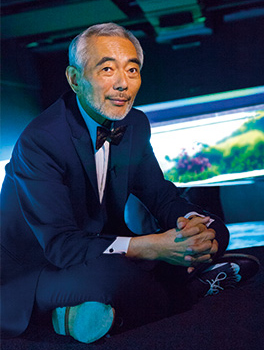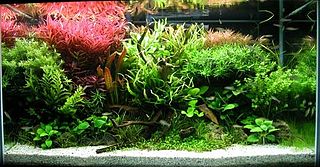
A terrarium is usually a sealable glass container containing soil and plants that can be opened for maintenance to access the plants inside; however, terraria can also be open to the atmosphere. Terraria are often kept as ornamental items.

Crinum is a genus of about 180 species of perennial plants that have large showy flowers on leafless stems, and develop from bulbs. They are found in seasonally moist areas, including marshes, swamps, depressions and along the sides of streams and lakes in tropical and subtropical areas worldwide.

Parachromis managuensis is a large species of cichlid native to freshwater habitats in Central America, where it is found from Honduras to Costa Rica. The binomial name refers to Lake Managua in Nicaragua, from which the holotype was obtained. It is a food fish and is also found in the aquarium trade where it is variously known as the jaguar cichlid, managuense cichlid, managua cichlid, guapote tigre, Aztec cichlid, spotted guapote and jaguar guapote. In Costa Rica, it is known as the guapote tigre.

Takashi Amano was a professional track cyclist, photographer, designer, and aquarist. His interest in aquaria led him to create the Japanese company Aqua Design Amano.

Aquascaping is the craft of arranging aquatic plants, as well as rocks, stones, cavework, or driftwood, in an aesthetically pleasing manner within an aquarium—in effect, gardening under water. Aquascape designs include a number of distinct styles, including the garden-like Dutch style and the Japanese-inspired nature style. Typically, an aquascape houses fish as well as plants, although it is possible to create an aquascape with plants only, or with rockwork or other hardscape and no plants.

Fishkeeping is a popular hobby, practiced by aquarists, concerned with keeping fish in a home aquarium or garden pond. There is also a piscicultural fishkeeping industry, serving as a branch of agriculture.

Taxiphyllum barbieri, known as Java moss or Bogor moss, is a moss belonging to the family Hypnaceae. Native to Southeast Asia, it is commonly used in freshwater aquariums. It attaches to rocks, roots, and driftwood. In the wild, it grows in humid riparian areas.

Taraporewala Aquarium or Taraporevala Aquarium is India's oldest aquarium and one of Mumbai's main attractions. It hosts marine and freshwater fish. The aquarium is located on Marine Drive.

A freshwater aquarium is a receptacle that holds one or more freshwater aquatic organisms for decorative, pet-keeping, or research purposes. Modern aquariums are most often made from transparent glass or acrylic glass. Typical inhabitants include fish, plants, amphibians, and invertebrates, such as snails and crustaceans.

The Sakuya Konohana Kan (咲くやこの花館) is a botanical garden set within one of the world's largest greenhouses, located in Tsurumi Ryokuchi park at 2-163 Ryokuchi Koen, Tsurumi-ku, Osaka, Japan. It is open daily except Mondays; an admission fee is charged.

Hygrophila polysperma, commonly known as dwarf hygrophila, dwarf hygro, Miramar weed, Indian swampweed or Indian waterweed, is an aquatic plant in the family Acanthaceae. It is native to Bangladesh, India, China and Malaysia, and has also been introduced to the US states of Florida, Texas and possibly Virginia. It is listed on the Federal Noxious Weed List in the US and is illegal to import and sell in a number of states including Kansas and South Carolina.

An aquarium is a vivarium of any size having at least one transparent side in which aquatic plants or animals are kept and displayed. Fishkeepers use aquaria to keep fish, invertebrates, amphibians, aquatic reptiles, such as turtles, and aquatic plants. The term aquarium, coined by English naturalist Philip Henry Gosse, combines the Latin root aqua, meaning 'water', with the suffix -arium, meaning 'a place for relating to'.
Christmas plants are flowers or vegetation from garden plants associated with the festive season of Christmas. There are also a wide variety of plants that include "Christmas" in their common name.

The Marine Life Park is a part of Resorts World Sentosa, Sentosa, situated in southern Singapore. The 8-hectare (20-acre) park is home to two primary attractions—the S.E.A. Aquarium and Adventure Cove Waterpark. Upon its opening in 2012, the S.E.A. Aquarium had the distinction of being the world’s largest oceanarium and public aquarium, a title it held through 2014, until it was surpassed by Chimelong Ocean Kingdom.
Vesicularia dubyana, known as Java moss or Singapore moss, is a species of moss native to Asia. It is common in the aquarium trade.
Jean Étienne Duby was a Swiss clergyman and botanist.

The Anna Scripps Whitcomb Conservatory is a greenhouse and a botanical garden located on Belle Isle, a 982-acre (397-hectare) island park located on the Detroit River within Detroit, Michigan. While located near the Canada–United States border, the island is entirely within the U.S. The park itself consists of 13 acres of preserved land for the conservatory and its botanical garden.

Fontinalis antipyretica, greater water-moss, or common water moss, is a species of submerged aquatic moss belonging to the subclass Bryidae. It is found in both still and flowing freshwater in Europe, Asia, Greenland and Africa. In North America it is found in most Canadian provinces with a seaboard and most US states except the most southern.
Vesicularia is a genus of mosses belonging to the family Hypnaceae.















